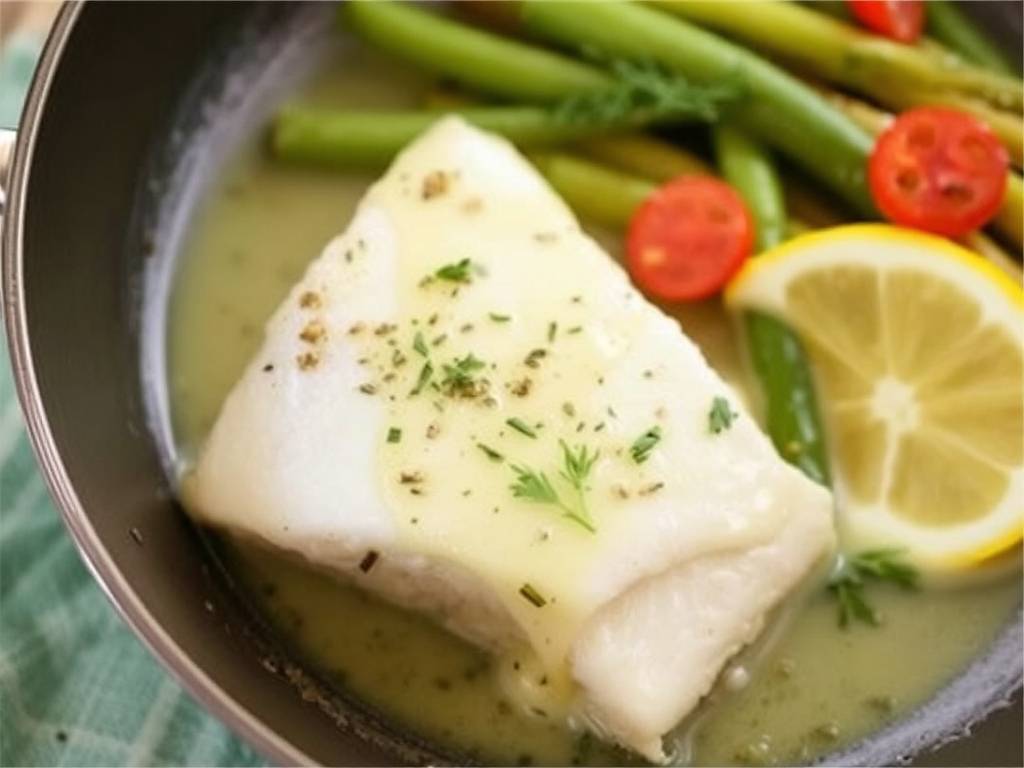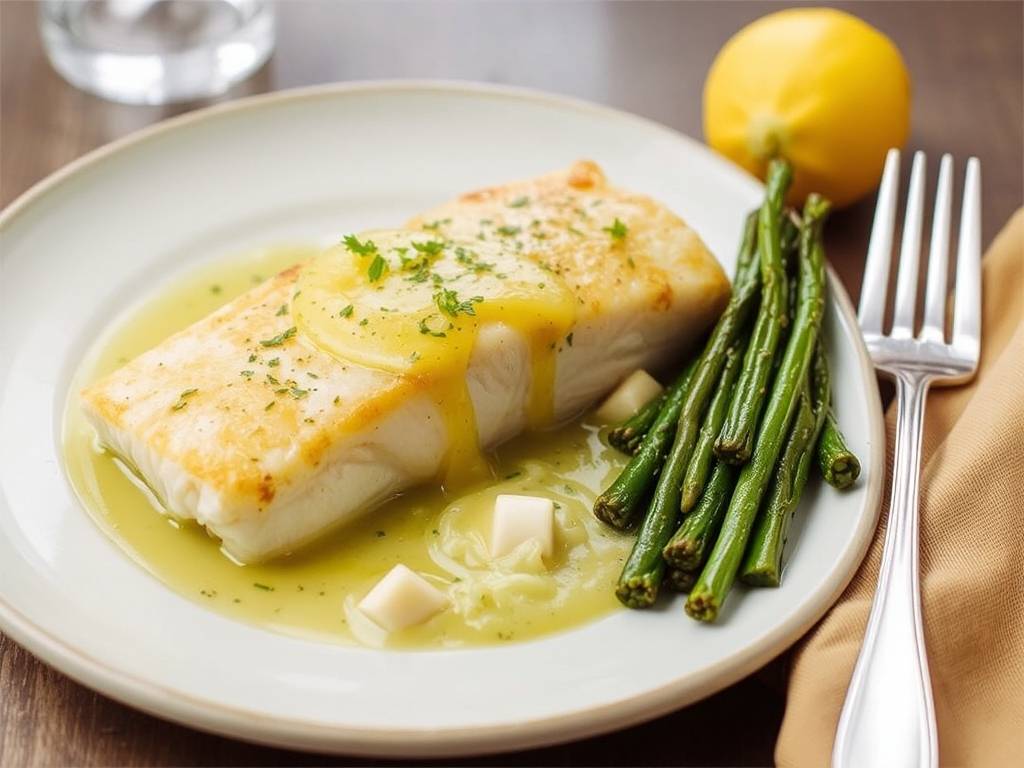A Culinary Journey: Mastering Pan-Seared Cod with Lemon Butter Sauce
Cod, with its mild flavor and flaky white flesh, serves as a magnificent canvas upon which a chef can paint a masterpiece of taste. Among the most classic and beloved preparations is the pairing with a simple yet sublime lemon butter sauce. This dish, often perceived as a restaurant delicacy, is deceptively easy to create at home. It requires not complex techniques or a pantry full of exotic ingredients, but rather an understanding of a few fundamental principles: the art of achieving a perfect sear, the science of emulsification, and the balance of bright acidity against rich, creamy fat. This guide will walk you through each step, transforming you from a novice cook into a confident creator of this timeless seafood classic.
The Foundation: Selecting Your Cod

The journey to an exceptional dish begins with the quality of your main ingredient. Not all cod is created equal. You will primarily encounter two types: Atlantic cod and Pacific cod. Atlantic cod tends to have a slightly sweeter, more delicate flavor and larger, thicker flakes. Pacific cod (also sold as Alaskan cod) has a milder taste and a firmer, chunkier texture. Both are excellent choices; your selection may come down to freshness, sustainability, and personal preference.

When purchasing, look for firm, translucent flesh that springs back when pressed gently. It should smell clean and briny, like the ocean, with no strong, "fishy" odor—a telltale sign of age. If buying frozen, which is often a fantastic and more sustainable option, ensure it is properly thawed. The best method is to place the vacuum-sealed package in a bowl of cold water in the refrigerator for several hours or overnight. Slow, cold thawing preserves the texture of the fish far better than quick methods like microwaving.
Preparation: The Key to a Crispy, Non-Stick Sear
A common frustration when cooking fish is it sticking to the pan and tearing apart. The secret to avoiding this lies in two factors: a dry surface and a hot pan.
- Pat Dry: Remove the cod fillets from their packaging and pat them thoroughly dry with paper towels. This is a non-negotiable step. Any surface moisture will instantly steam in the hot pan, creating a barrier that glues the fish to the surface. A dry exterior is the first and most crucial step toward a beautiful, golden-brown crust.
- Seasoning: Season both sides of the fillets generously with kosher salt and freshly ground black pepper. Do this just before cooking. Salting too far in advance can start to draw moisture out of the fish, working against your drying efforts.
- The Pan and the Fat: A heavy-bottomed skillet is essential. Cast iron or stainless steel are ideal because they distribute heat evenly and can withstand and retain high temperatures. Non-stick pans can work but often don't develop as deep a sear. Add a high-smoke-point oil, such as avocado oil, grapeseed oil, or clarified butter (ghee), to the pan. Regular butter will burn at the high heat needed for searing. Heat the oil over medium-high heat until it shimmers.
The Art of the Sear: Cooking the Cod to Perfection
Place the cod fillets in the hot pan, presentation-side down (the side that was skin-side, if it had skin). You should hear an immediate, confident sizzle. A quiet pan means the heat is too low. Resist the urge to move the fish! Let it cook undisturbed for 3-4 minutes, depending on the thickness of the fillets. This allows a crust to form, which will naturally release from the pan.
Using a thin, flexible spatula, gently lift a corner of a fillet to check the color. It should be a deep, golden brown. Once achieved, carefully flip the fillets. If they resist, give them another 30 seconds. They will release when ready.
Cook on the second side for another 2-4 minutes. The goal is to cook the cod until it is just opaque throughout and flakes easily with a fork. The FDA recommends an internal temperature of 145°F (63°C), but many chefs prefer to pull it from the heat at around 135-140°F (57-60°C), as the residual heat will continue to cook it, resulting in a more moist and tender texture. Overcooking is the enemy of good fish, leading to a dry, tough result. Once cooked, transfer the cod to a warm plate and tent loosely with foil while you prepare the sauce.
Crafting the Sauce: A Symphony of Lemon and Butter
The pan you just cooked the fish in is a treasure trove of flavor. Those browned bits stuck to the bottom, known as fond, are the foundation of your sauce. Do not wash the pan!
- Deglaze: Reduce the heat to medium. Pour in a quarter cup of dry white wine, such as Sauvignon Blanc or Pinot Grigio. Using a wooden spoon or whisk, scrape all the flavorful browned bits from the bottom of the pan. Let the wine simmer and reduce by about half, which will take 1-2 minutes. This step cooks off the alcohol and concentrates the flavor. If you prefer not to use wine, you can substitute with a low-sodium chicken or vegetable broth, though the wine adds a wonderful acidity that complements the lemon.
- The Acid: Fresh Lemon Juice: Add the fresh juice of one lemon to the reduced wine. Let it bubble for another minute. The sharp, bright acidity of the lemon will cut through the richness of the butter to come.
- Mounting with Butter: The Emulsification: This is the most technical part, but it's simple with care. Reduce the heat to low. Cut your cold, unsalted butter into small, tablespoon-sized cubes. Start adding the butter to the pan one or two pieces at a time, whisking constantly and vigorously. As each piece melts and incorporates, add the next. The goal is to create an emulsion, where the fat from the butter is suspended in the watery lemon-wine liquid, creating a smooth, creamy, and slightly thickened sauce. The key is low heat and constant motion. If the heat is too high, the sauce will "break," meaning the fat will separate, creating an oily puddle.
- Finishing Touches: Once all the butter is incorporated, turn off the heat. Stir in a tablespoon of chopped fresh parsley or chives for a touch of color and freshness. Taste the sauce and adjust the seasoning with a pinch of salt and pepper. If it's too sharp, a tiny pinch of sugar can balance it. If it's too thin, you can let it reduce slightly over very low heat, but be careful not to break the emulsion.
Plating and Presentation
Place a warm cod fillet in the center of each plate. Spoon the vibrant, creamy lemon butter sauce generously over the top. The sauce should cascade down the sides of the flaky fish. For a complete meal, consider your accompaniments. This dish pairs beautifully with:
- Simple Steamed Asparagus: The crisp-tender vegetable is a perfect vehicle for the sauce.
- Garlic Mashed Potatoes: The creamy potatoes provide a neutral base that soaks up the delicious sauce.
- Sautéed Spinach: A quick wilt of spinach in the pan before you start the fish makes for a flavorful and healthy bed.
- Lightly Buttered Rice or Orzo: A simple starch to complement without overpowering.
Variations and Enhancements
Once you have mastered the basic recipe, feel free to experiment and make it your own.
- Capers: Add a tablespoon of rinsed capers to the sauce along with the lemon juice for a briny, salty punch.
- Herbs: Incorporate other fresh herbs like dill, tarragon, or thyme. Dill, in particular, is a classic pairing with fish.
- Shallots: For a more complex base, finely mince a small shallot and sauté it in the pan after removing the fish and before deglazing with wine.
- Cream: For an even richer sauce, stir in a tablespoon or two of heavy cream after the wine has reduced, then proceed with the butter.
Cooking cod with lemon butter sauce is more than just following a recipe; it is an exercise in technique and balance. It teaches patience with the sear, precision with the sauce, and respect for the primary ingredient. The result is a dish that is elegant enough for a dinner party yet simple enough for a weeknight meal. It is a testament to the fact that the most memorable culinary experiences often come from the humblest, most perfectly executed preparations. So, arm yourself with a good pan, fresh ingredients, and a little confidence, and embark on this delicious journey. Your taste buds will thank you.






发表评论